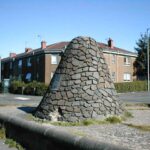[av_textblock size=” font_color=” color=”]
Marjory Bruce
Marjory Bruce Monument on Renfrew road “press for bigger image & for inscription”
A large stone cairn stands sentinel in Renfrew road, Paisley. This latter day “Paisley pyramid”, was built upon a legend. It is known as Marjory Bruce’s monument. Locals will tell you that, on this spot, an event took place that changed Scotland’s History. The story, part legend, part truth, which surrounds this modern pile of stones, is both romantic and sad.
Princess Marjory Bruce was the daughter of King Robert the Bruce. During the war with England, she had been captured and taken as a hostage by the “Auld Enemy”. She was to spend years of cruel incarceration in the Tower of London. After the battle of Banockburn in 1314, she was released.
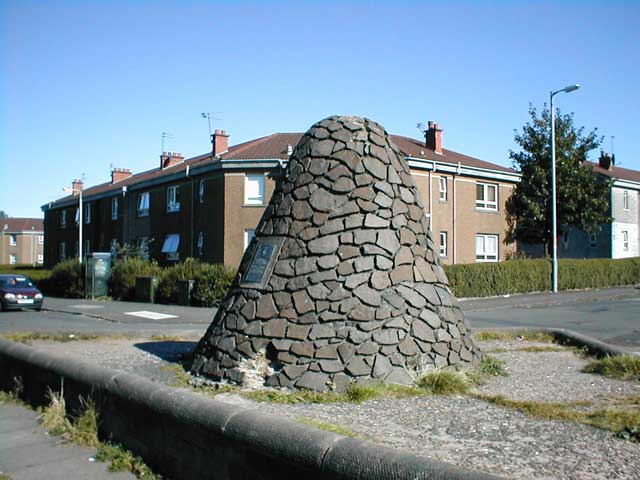
“Battle of Bannockburn”
Princess Marjory returned to Scotland under the escort of Walter Fitzalan, a descendant of the Walter Fitzalan who founded Paisley Abbey. The young Walter, as High Steward to the King, had played an important role at the battle of Bannockburn. As one of the King’s most deserving subjects and royal favourite, Walter was rewarded with the hand of Marjory in marriage. They were married in May 1315.
Legend has it that, on March 2nd, 1316, Marjory was returning to her husband’s castle at Renfrew. Riding through the lands of Knock, which lay between Paisley and Renfrew, she was accidentally throw from her horse. Her fall caused a dislocation of her neck bone and death soon followed. As she was heavily pregnant with Walter’s child and no skilled person was at hand, a country fellow boldly acted as surgeon. He succeeded in delivering the baby by Caesarian operation. During the operation, the baby boy’s eye was badly cut. This scar, in later life, gave the child, Robert, the nickname “Blearie eye”. Blearie or bleir in old Scots means something that obscures the sight.
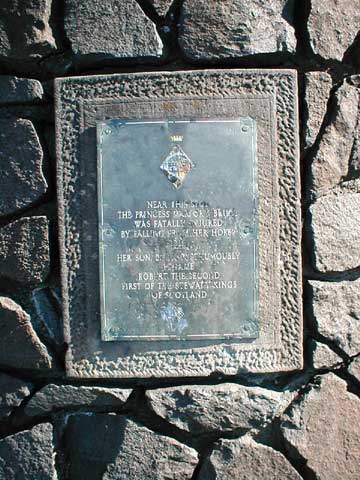
“King Blearie ”
When he later became the first Stewart King of Scots, as Robert II, he was dubbed “King Blearie” and his mother Marjory, “Queen Blearie”, although she never was Queen. That is the legend.
However, it is more likely that Marjory died in childbirth at her husband’s Castle in Renfrew Her son, Robert, survived to live a long life for those times. When he became king at the late age of fifty-five, he managed to rule for a further nineteen years. He is on Record as being the oldest person ever to wear the Scottish crown! In the matter of his appearance, one contemporary French historian, Froissart, described this King of Scots as “blearie eyed”. However, Fordun, a Scottish historian, makes no mention of his eyes, but describes him as a “comedy young man”. perhaps, in later life, this soldier king received a battle scar near his eyes, or perhaps he suffered from inflammation of the eyes.
For several centuries, local and national historians wrote of the legend of Marjory Bruce. An older monument, near the present day cairn, was called “Queen Blearies Stane” by the locals. It was an octagonal plinth. The plinth was removed in 1779. The stones were used to repair field walls of a nearby farm. a piece of the column was used for a barn door lintel.
“A memorial battle”
This older monument was not, however built to mark the spot where Marjory fell of her horse, but to commemorate the important battle of Renfrew of 1164. Over the centuries, the older monument had been known in folk memory as “Cuimhne Blair”, the old Gaelic words meaning “a memorial of battle”. This, sounding like “Queen Blear”, may explain why the monument became associated with Marjory Bruce.
The man who won the Battle of Renfrew in 1164, was the first Walter Fitzalan, High Steward and founder of Paisley Abbey. He was the man who erected the earlier monument, now lost, near the present day site of the cairn on Renfrew road. On his seal of 1170, Walter is depicted leaning against a pillar. This pillar can only refer to his monument, built to commemorate the site of his great victory against Somerled, Lord of the Isles.
“Safe deliverance”
This victory was the sternest test of Walter’s military prowess. With his success in this battle, he had not only saved his own Lands at Renfrew, but saved Scotland from being overrun by the rebellious “Highland Hordes”. it is also possible that paisley Abbey may have been built by Walter in thanksgiving for his safe deliverance in this battle. The possible year of its foundation may date from 1164, the year of the battle, and not 1163 as is commonly accepted.
Marjory Bruce’s Cairn, in the busy setting of the 20th century, reminds passers-by of Scotland’s turbulent past and the legend of “Queen Blearie”
“Taken from David Rowands book Golden Threads ISBN 0-9536886-0-7″
[/av_textblock]
[av_hr class=’default’ height=’50’ shadow=’no-shadow’ position=’center’ custom_border=’av-border-thin’ custom_width=’50px’ custom_border_color=” custom_margin_top=’30px’ custom_margin_bottom=’30px’ icon_select=’yes’ custom_icon_color=” icon=’ue808′]
[av_textblock size=” font_color=” color=”]
Marjory Bruce was the eldest daughter of King Robert the Bruce, by his first wife, Isabella of Mar. Marjory died on 2 March 1316 at the age of 19. She is buried at Paisley Abbey.
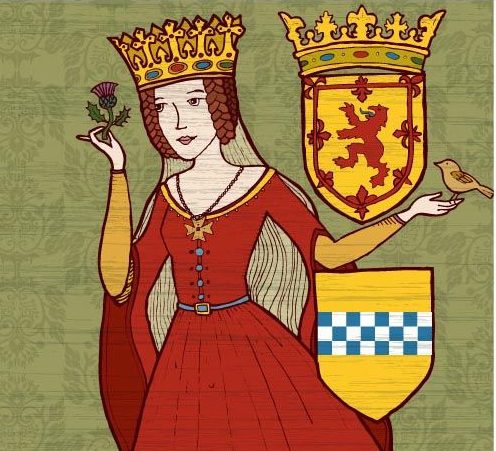
On 27 March 1306, Robert the Bruce was crowned King of Scots and Marjory, at 9 years old, became a Princess.
Three months after her coronation, during the war with England, the Bruce women were sent north to Kildrummy Castle for safety. The English army were waiting and the women were captured by the Earl of Ross and handed over to the English King.
The women were taken as prisoners. Marjory spent years in solitary confinement at the Gilbertine nunnery at Watton, East Yorkshire. Bruce couldn’t do anything to save his family until June 1314, when, at the Battle of Bannockburn, he crushed the English troops, taking many hostages. Some of the most important prisoners could now be exchanged for his wife, daughter, and sisters.
Princess Marjory returned to Scotland under the escort of Walter Fitzalan, a descendant of Walter Fitzalan who founded Paisley Abbey. The young Walter, as High Steward to the King, had played an important role at the Battle of Bannockburn. As one of the king’s most deserving subjects and royal favourite, Walter was rewarded with the hand of Marjory in marriage. They were married in May 1315.
On 2 March 1316, Marjory was riding her horse in Gallowhill, while heavily pregnant. Her horse suddenly startled and threw her to the ground at a place called “The Knock”. She went into premature labour and Robert was delivered by caesarian section at Paisley Abbey. Sadly, Marjory died a few hours later. Robert went on to become the first King of the Stewart dynasty, Robert II.
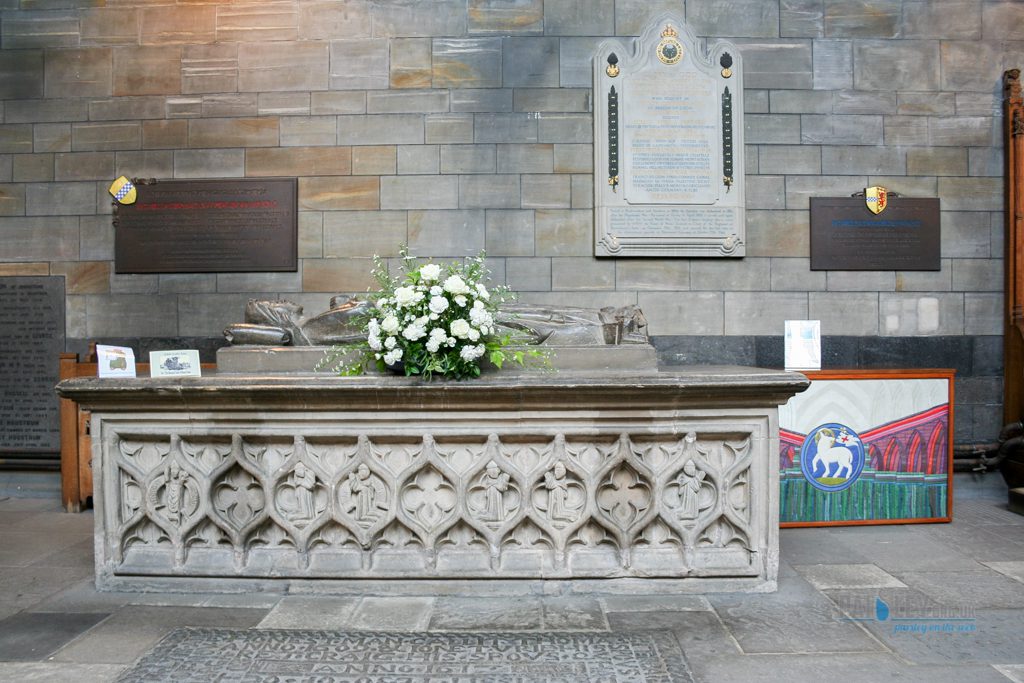
In January 1954 a cairn was unveiled at the junction of Dundonald Road and Renfrew Road. The cairn marks the spot close to where Marjory fell from her horse. The reputed place of death is now referred to as “the knock”, with nearby roads of Bruce Way, and Marjory Drive named in her honour.

The cairn has a plaque with the inscription “Near the princess Marjory Bruce was fatally injured by falling from her horse 1316. Her son born posthumously became Robert the second First of the Stewart kings of Scotland”.

Marjory’s life was short lived and surrounded by tragedy. The cairn is a reminder to passers-by of Scotland’s history and the devastating events which took place.
[/av_textblock]


